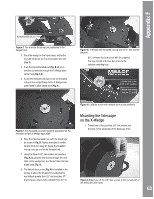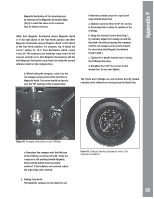Meade Tripod LX600-ACF 14 inch User Manual - Page 68
Assembly, Appendix H
 |
View all Meade Tripod LX600-ACF 14 inch manuals
Add to My Manuals
Save this manual to your list of manuals |
Page 68 highlights
ApApsesnedimxblHy APPENDIX H: MANUAL DRIFT ALIGNMENT How to manually Drift Align the LX600 Telescope (Northern Hemisphere). The LX600 with StarLock is specially equipped to perform an Automatic Drift Alignment. In the Autostar Setup/Align menu, select "Drift Alignment" and the LX600 will guide you through a quick Automatic drift alignment procedure. This method is substantially quicker than the manual drift alignment method. However, if you prefer to drift align the mount using the manual drift alignment procedure, follow the steps below. NOTE: In order to perform the manual drift alignment with the LX600, it is necessary to disable the Starlock by turning it off in the Utilities menu. Important Note: You will need a reticle eyepiece to perform this procedure. 1. Center your reticle on a bright star near the Eastern horizon. For best results, the star should be about 20 or 30 degrees above the eastern horizon and within +/- 5 degrees from the celestial equator. 2. Look through the reticle while pressing Autostar's right and left Arrow keys. This will slew the mount back and forth in the RA axis. 3. Loosen and rotate the reticle until one of the crosshairs matches the right-left path of the star as you press the Arrow keys. This crosshair is now on the RA axis. The other axis is therefore on the DEC axis. Carefully secure the reticle in place (do not move the crosshairs for the rest of this procedure). 4. Observe the bright star you have chosen. If, over time, it drifts off the RA axis, use the latitude adjustment knob on the X-Wedge to bring it back past center. Experience will teach you how much to move the latitude knob. If the star drifts slowly, use only a small amount of correction; if it moves quickly, use a much larger amount of correction. 5. Use Autostar's up and down keys to bring the star back to center. Perform step 4 repeatedly until it does not drift on the DEC axis for a few minutes. 6. Next, center on a bright, Southern star. This star should be within 10° to 20° of the celestial equator. 7. If the star drifts above the RA axis, use the Azimuth adjustment knob on the X-Wedge to move the star to the right and down until the star is almost out of the field of view. If it drifts below the RA axis, use the Azimuth adjustment knob to move the star to the left and up. 8. Use Autostar arrow keys to center the star again. Repeat steps 7 and 8 until the star no longer drifts off the RA axis for a few minutes. 9. Go back and check the first star and see if it is drifting again. And then recheck the second star also. Keep repeating steps 4, 7 and 8, until there is no more drift in either of the stars you have chosen for a few minutes. Your telescope is now drift aligned. 68














